How long can a cat go without eating?
Written by Noa |
There’s a short answer to that: A cat can’t go without food! In this blog, we’ll explain why.

Written by Noa |
There’s a short answer to that: A cat can’t go without food! In this blog, we’ll explain why.

There are many reasons why a cat might refuse food. The most common causes include:
If your cat refuses food but is otherwise playful and lively, you can try offering different food.
A nauseous cat may still show interest in food. However, an aversion to their usual kibble can develop. For example, your cat might run to the bowl when it’s placed down, sniff the food, but then walk away without eating. As an owner, this may seem like your cat wants to eat but can’t. Often, this is not the case. Offering a different type of food may encourage your cat to eat again.
This situation should not last longer than 48 hours. If your cat still doesn’t eat after that, you must contact your veterinarian for a check-up and supportive care.
Is your cat sick? Is it vomiting, drooling, grinding its teeth, or showing other unusual behavior? Then it’s time to visit the vet! The sooner your cat gets help to start eating again, the faster it will recover.
Your vet will start by performing a physical exam and, if needed, additional diagnostics to find the cause of your cat’s reduced appetite.
Treatment depends on the underlying cause. Often, the cat will receive an anti-nausea injection, and sometimes an appetite stimulant is given.
If needed, your vet will assist with feeding. This may involve giving special recovery food using a feeding syringe directly into the mouth. Another option is placing a nasal or esophageal feeding tube. Although a feeding tube may sound invasive, it is often easier for cat owners and less stressful for the cat.
Still have questions about a cat that won’t eat? Feel free to contact us at veterinarian@vetsend.co.uk

Add products to view your basket
We use cookies to help us serve you better and more personally. Functional cookies ensure that the website works properly and have an analytical function. We also use technology to track your behaviour anonymously, both inside and outside our website. Personal data and cookies may be used for personalisation or advertising. Want to know more? Read our privacy policy and cookie statement here. If you choose to reject, we will only place functional and analytical cookies.
